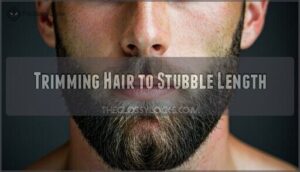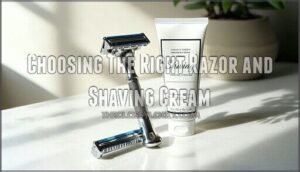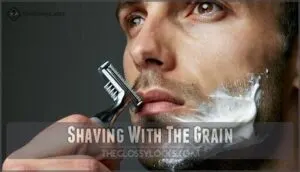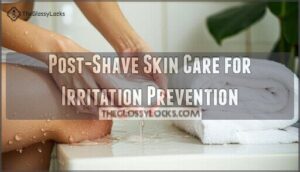This site is supported by our readers. We may earn a commission, at no cost to you, if you purchase through links.
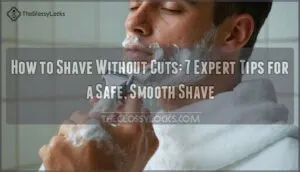
Always shave with the grain using light, short strokes, and rinse your blade frequently to prevent clogging. Think of it like mowing grass: you wouldn’t press down hard or go against the natural direction. Skip the repeat passes over the same spot, which turns skin into hamburger meat.
Finish with cold water to close pores, then moisturize. The devil’s in the details in terms of sophisticated technique and tool selection.
Table Of Contents
- Key Takeaways
- Pre-Shave Preparation for a Cut-Free Shave
- Choosing The Right Razor and Shaving Cream
- Effective Shaving Techniques to Avoid Cuts
- Post-Shave Skin Care for Irritation Prevention
- Extra Tips for a Safe and Smooth Shave
- Frequently Asked Questions (FAQs)
- How to shave without cutting yourself?
- Should you shave while shaving?
- Can You Cut Your Skin while shaving?
- What should I do if I get a cut while shaving?
- How to prevent cuts when shaving your face?
- Can you get cut while shaving your legs?
- Why do I always get cuts when shaving?
- How do you stop shaving cuts?
- How does shaving not cut you?
- How to not cut yourself when shaving down there?
- Conclusion
Key Takeaways
- Prep your skin properly – Soften whiskers with warm water for 2 minutes and trim long hair to stubble length before you start shaving.
- Use sharp, quality tools – Replace dull blades every 5-7 shaves and choose razors with protective guards or lubrastrips that work with your skin type.
- Master gentle technique – Shave with the grain using light, short strokes and don’t repeat passes over the same area to avoid irritation.
- Follow up with proper aftercare – Rinse with cold water to close pores, then apply aftershave and moisturizer to repair your skin barrier.
Pre-Shave Preparation for a Cut-Free Shave
You can’t rush into shaving without proper prep if you want to avoid those painful nicks and cuts that’ll have you looking like you wrestled with a cheese grater.
Taking just a few minutes to cleanse, exfoliate, trim your hair to stubble length, and soften everything with warm water transforms your face into the perfect canvas for a smooth, irritation-free shave.
Cleansing With Gentle Face Wash
Before shaving, cleanse with warm water and a gentle face wash to remove oil buildup that clogs razors. Choose a pH-balanced cleanser with mild ingredients to avoid ingredient sensitivity while maintaining proper cleansing frequency.
Use gentle lathering techniques—massage the product into damp skin for thirty seconds. This simple step prevents razor drag and creates the foundation for a cut-free shave.
Exfoliating to Remove Dead Skin
Exfoliation removes the roadblock between your razor and a smooth shave. Dead skin cells create friction that leads to nicks, so scrub away dead skin with gentle exfoliating ingredients twice weekly.
Use circular motions with an exfoliating scrub or washcloth before shaving. This simple step reduces razor drag by up to 68%, making your blade glide effortlessly across clean skin.
Trimming Hair to Stubble Length
Long hair spells trouble for your razor and skin. Trim your beard down to stubble before shaving to prevent razor drag and shaving cuts.
Here’s your stubble length guide:
- Use a beard trimmer on setting "1" for ideal stubble maintenance tips
- Go guard-less for 0.2-0.5mm stubble if you’re confident with your trimming tool choice
- Keep stubble consistent to prevent ingrown hairs and guarantee smooth blade gliding
This simple step transforms your shave from a wrestling match into a breeze.
Softening Hair With Warm Water or Towel
Transform your shave prep with this simple trick: soak a clean towel in warm water and press it against your face for two to three minutes. The heat opens pores while hydration benefits soften stubble, reducing shaving cuts and nicks.
Different hair types need varying softening duration—coarse hair requires longer steaming. This towel temperature technique beats rushing into shaving unprepared.
Choosing The Right Razor and Shaving Cream
Your razor and shaving cream choices can make the difference between a smooth shave and a face full of nicks. Think of your razor as a precision tool, not a bulldozer—sharp blades with features like lubrastrips and skin guards work with your skin, while quality shaving cream creates the slick barrier that lets everything glide effortlessly.
Selecting a Safe Razor Type
With countless razor options available, selecting the right type can make or break your shaving experience. Here’s how to choose wisely:
- Safety razor: Single blades with protective guards minimize skin contact and reduce cuts by 40% compared to cartridge razors
- Cartridge razor: Multi-blade systems with pivoting heads distribute pressure evenly, preventing nicks through sophisticated engineering
- Electric razors: Oscillating blades beneath protective foils eliminate direct skin contact, ideal for sensitive skin razors needs
Consider razor handle grip and blade count when making your choice; using razors with precision-engineered blade tips can further reduce the risk of cuts.
Signs of a Dull or Damaged Blade
When your razor blade starts giving you grief, it’s time for a replacement. Sharp blades glide effortlessly, while dull ones demand increased pressure and cause tug and irritation.
| Warning Sign | What You’ll Notice | Action Needed |
|---|---|---|
| Blade Rust | Orange/brown spots on edges | Replace immediately |
| Blade Chips | Nicks or gaps in cutting edge | Swap for new blade |
| Lubrastrip Condition | Worn, cracked, or missing strip | Time for fresh razor blades |
Trust your skin—if shaving feels like dragging sandpaper across your face, that blade’s done its job.
Using Shaving Cream or Pre-Shave Oil
Quality shave prep makes all the difference between a smooth glide and painful nicks. Apply shave cream or preshave oil generously to create that protective barrier your skin craves.
Consider these application techniques for better results:
- Cream ingredients matter – look for glycerin and natural oils for skin sensitivity
- Oil benefits include deeper moisturizing and reduced razor drag
- Product comparison shows oils work best for coarse hair, creams for daily shavers
Work the product in circular motions, letting it soften whiskers for thirty seconds before shaving.
Effective Shaving Techniques to Avoid Cuts
Now that you’ve got your gear ready, it’s time to master the technique that’ll keep your face nick-free.
The way you handle your razor makes all the difference between a smooth, comfortable shave and looking like you wrestled with a particularly aggressive house cat.
Shaving With The Grain
When shaving with the grain, you’re following your hair growth direction, which dramatically reduces irritation and prevents shaving cuts. Map your face’s natural patterns first, then glide smoothly in those directions.
This first pass importance can’t be overstated—it’s your foundation for ingrown hair prevention. This technique delivers reduced irritation while ensuring a smoother shave experience.
Using Light, Short Strokes
Gentle strokes make all the difference in preventing shaving cuts. Think of your razor like a paintbrush—let it glide smoothly across your skin with minimal stroke pressure.
Keep consistent strokes short, about an inch long, maintaining the proper blade angle. Don’t rush or skip areas.
Light, controlled movements help you avoid dragging the blade, which causes irritation and nicks.
Rinsing The Blade Frequently
When blade rinse frequency drops, your razor becomes a magnet for trouble. Warm water temperature works best for dissolving residue buildup prevention during each stroke. Don’t let clogged blade issues sabotage your smooth shave.
- Rinse between every stroke – Hot water melts away cream and whiskers instantly
- Use a sharp razor with effective rinse methods – Shake excess water to maintain blade precision
- Watch for stubborn buildup – Tap gently against the sink edge when rinsing fails
Avoiding Repeated Passes Over The Same Area
After rinsing your blade, resist the temptation to go over the same spot twice. One pass with proper technique beats multiple passes that minimize irritation and prevent razor burn. Your MultiBlade cartridge should handle stubborn hairs in a single stroke when you refine technique through gentle shaving.
| Multiple Passes Risk | Single Pass Benefit |
|---|---|
| Increases shaving cuts and nicks | Reduce ingrowns effectively |
| Creates razor burn patches | Maintains skin integrity |
| Amplifies irritation levels | Preserves natural oils |
Think of shaving like painting—you wouldn’t keep brushing over wet paint.
Post-Shave Skin Care for Irritation Prevention
Your work isn’t done once you’ve finished your last stroke, because what you do next determines whether you’ll walk away with smooth skin or spend the day dealing with razor burn.
Think of post-shave care as the cool-down after a workout—it’s when your skin recovers from the blade’s assault and rebuilds its natural defenses against irritation.
Washing With Cold Water to Close Pores
That invigorating splash works like magic—cold water benefits include instant pore size reduction, which helps prevent bacteria from entering your freshly shaved skin. Your post-shave rinse should use genuinely cold water, not lukewarm.
Water temperature effects are immediate: cold water tightens skin, preventing shaving cuts from becoming infected. This simple step creates a natural barrier against irritation and bacteria prevention.
Applying Aftershave or Toner
Once you’ve closed your pores, apply aftershave to soothe irritated skin and restore balance. This step helps prevent shaving cuts and nicks while addressing sensitivity concerns.
Aftershave benefits include reducing bacteria and calming inflammation from razor friction.
- Choose alcohol-free formulas for sensitive skin to avoid stinging
- Consider balm vs. toner – balms moisturize while toners restore pH
- Check toner ingredients like witch hazel for natural anti-inflammatory benefits
Moisturizing for Skin Barrier Repair
After applying aftershave, your skin needs hydration to complete the healing process. Applying moisturizer rehydrates parched skin and promotes long-term benefits by repairing damage from razor friction.
Look for products with soothing ingredients that address skin sensitivity. This final step rebuilds your skin’s protective barrier, preventing flakiness and irritation that can worsen over time.
Extra Tips for a Safe and Smooth Shave
You’ve covered the fundamentals, but mastering these final techniques will transform your daily routine from a potential battleground into a smooth, confident experience.
These professional secrets address the small details that separate amateur shavers from those who never worry about nicks, cuts, or post-shave regret.
Maintaining and Storing Your Razor
After each shave, rinse your razor thoroughly with warm water to remove hair and cream buildup. Store it in a cool, dry place to prevent rust and extend blade lifespan.
Clean the handle regularly and replace razor blades every five to seven shaves for best performance. Proper razor care tips include avoiding humid storage environments and using sharp razor blades consistently.
Avoiding Excessive Pressure
Think of your razor as a feather, not a hammer. Excessive pressure during shaving causes most nicks and cuts by forcing blades to dig into skin.
Let the razor do the work through proper blade pressure control and gentle shaving techniques. Light razor glide with minimal pressure distribution prevents cuts while maintaining effective hair removal.
Trust the blade’s design for minimizing nicks.
Shaving Sensitive or Problem Areas
Shaving bikini lines, necks, and other contoured areas requires finesse. Hold skin taut to create smooth surfaces, preventing shaving nicks and razor burn. Use light strokes with the grain to minimize folliculitis prevention concerns.
Stretch problem areas gently—this flattens bumps from keratosis pilaris while avoiding irritation. When shaving sensitive areas, slower movements trump speed every time.
Using a quality razor is essential for a smooth shave.
Sun Protection After Shaving
Fresh-shaved skin shows increased UV sensitivity, making sun protection essential. Your newly exposed skin acts like a blank canvas—vulnerable to damage. Apply moisturizer with SPF 30+ immediately after shaving, then reapply broad-spectrum sunscreen every two hours. This prevents irritation and aids healing.
- Choose moisturizers containing healing ingredients like aloe vera or chamomile
- Select broad-spectrum sunscreen with zinc oxide for sensitive post-shave skin
- Maintain consistent reapplication frequency, especially during outdoor activities
Frequently Asked Questions (FAQs)
How to shave without cutting yourself?
Prep your skin with warm water, use sharp blades, shave with the grain using light pressure, and let the razor do the work—no forcing needed.
Should you shave while shaving?
You shouldn’t shave while already shaving – that’s redundant. Instead, focus on proper prep: soften hair with warm water, use quality shaving cream, and make single gentle passes with sharp blades.
Can You Cut Your Skin while shaving?
Studies show men experience shaving cuts 68% more often when skipping proper prep.
Yes, you can definitely cut your skin while shaving—it’s one of the most common grooming mishaps that happens when you rush or use dull blades.
What should I do if I get a cut while shaving?
Apply pressure immediately to stop bleeding, then rinse with cold water. Dab on an antiseptic or styptic pencil to prevent infection and seal the wound quickly.
How to prevent cuts when shaving your face?
Think your face is tougher than a medieval knight’s armor? Think again.
Soften hair with warm water, use sharp blades, shave with the grain using light pressure, and let the razor glide—don’t drag it across your skin.
Can you get cut while shaving your legs?
Yes, you can definitely get cut while shaving your legs. Using dull blades, applying too much pressure, or rushing through curved areas like ankles increases your risk of nicks and cuts substantially.
Why do I always get cuts when shaving?
You’re shaving like a bull in a china shop! You’re likely applying too much pressure, using a dull blade, or skipping prep work.
Lighten your touch, replace worn razors, and soften hair with warm water first.
How do you stop shaving cuts?
Stop cuts by using light pressure, shaving with the grain, keeping your blade sharp, and prepping skin with warm water. Let the razor do the work—don’t force it.
How does shaving not cut you?
Like a skilled dancer avoiding missteps, your razor glides safely when you prep properly, use light pressure, and let sharp blades do the work instead of forcing them.
How to not cut yourself when shaving down there?
Trim hair short first, then use plenty of shaving cream or gel.
Go slowly with the grain, use light pressure, and keep your skin taut. Rinse the razor frequently between strokes.
Conclusion
Mastering how to shave without cuts is like learning to ride a bike—once you’ve got the fundamentals down, it becomes second nature. You’ve now got the roadmap: proper prep work, quality tools, gentle technique, and solid aftercare.
Remember, your skin isn’t a football field that needs aggressive tackling. Take your time, respect the grain direction, and don’t chase flawlessness on your first attempt. With consistent practice using these expert tips, you’ll transform your daily shave from a risky ordeal into a smooth, confident routine.
- https://athenaclub.com/blogs/news/how-to-prevent-and-treat-shaving-cuts-and-nicks-quickly
- https://kayakama.com/how-to-shave-without-injuring-your-skin-and-post-shave-care-tips-for-men/
- https://health.clevelandclinic.org/how-to-shave
- https://www.clinikally.com/blogs/news/10-effective-ways-to-stop-shaving-cut-bleeding
- https://www.aad.org/public/everyday-care/skin-care-basics/hair/razor-bump-prevention



